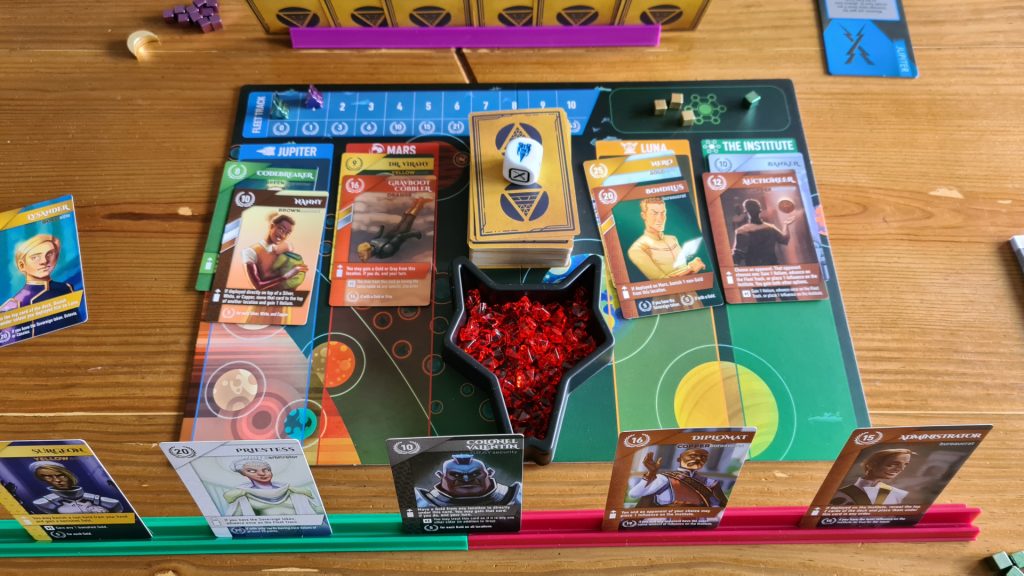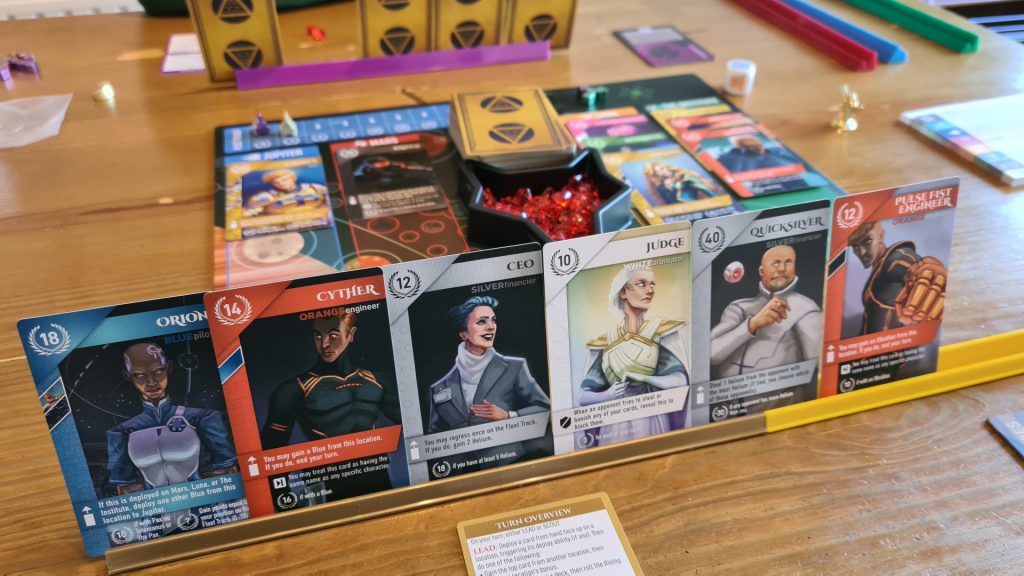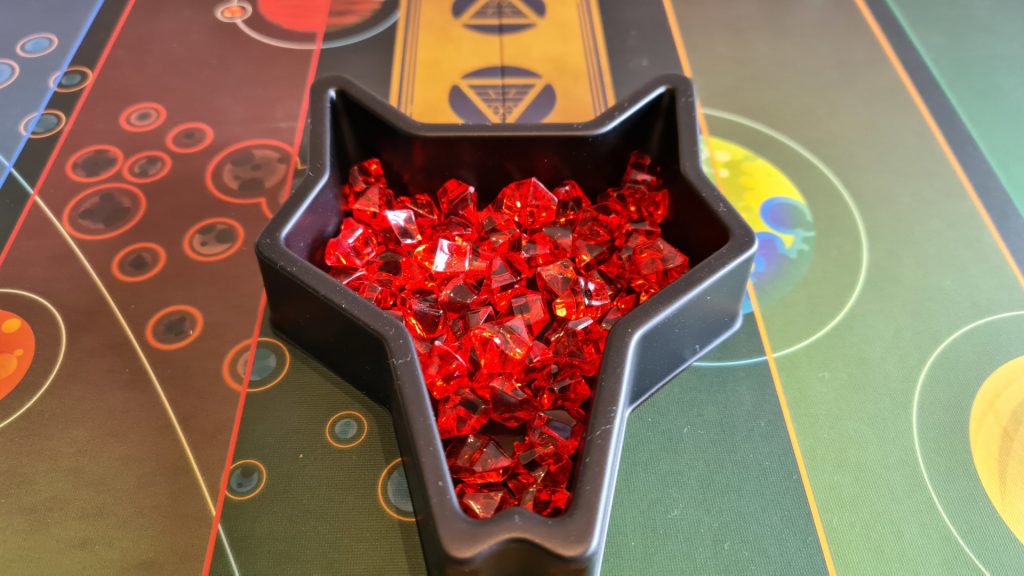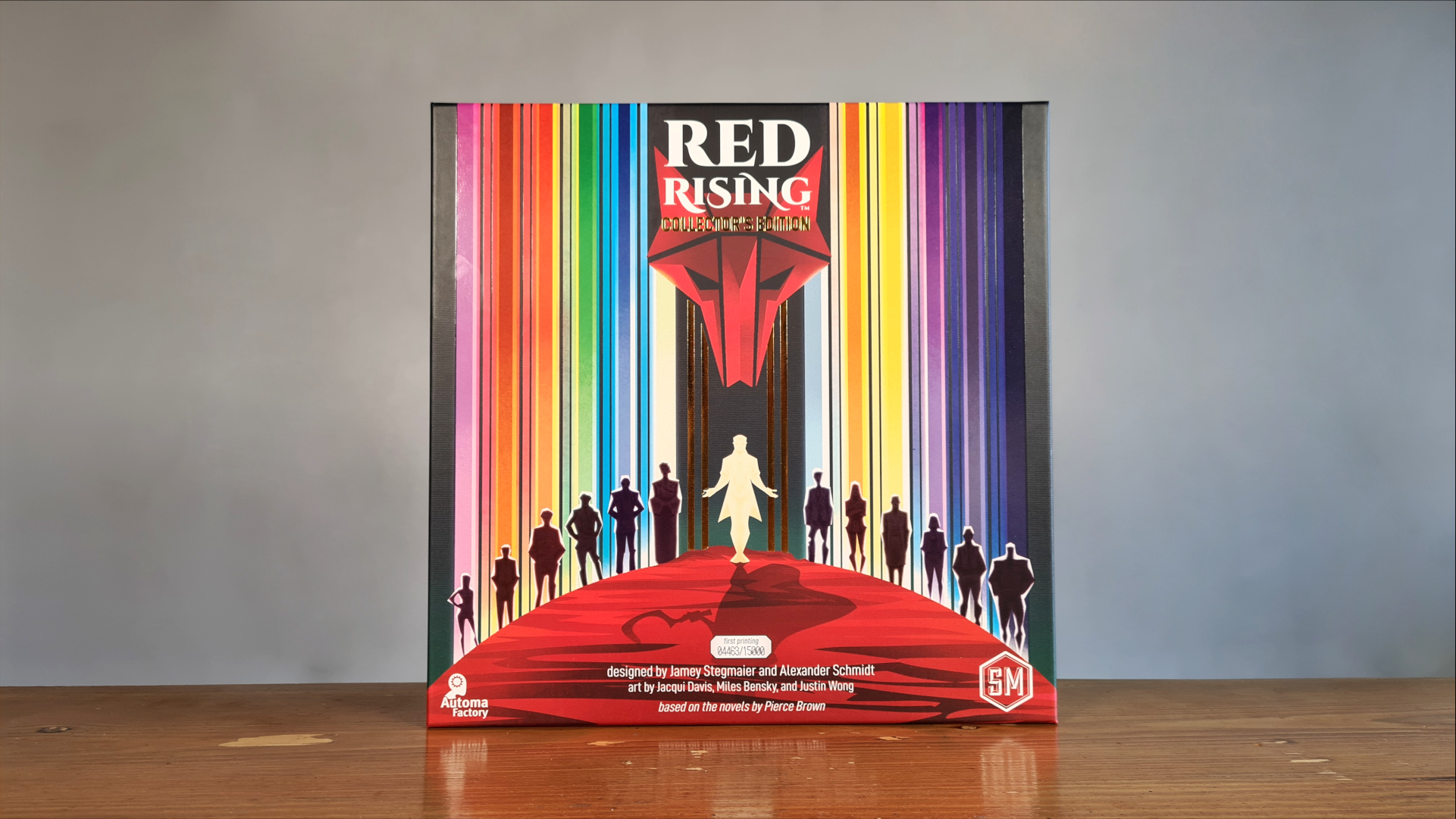Red Rising is the new board game from Stonemaier Games, based on the book series of the same name. Designed by Alexander Schmidt and Jamey Stegmaier, featuring artwork from Jacqui Davis, Miles Bensky and Justin Wong, the game sees 1 – 6 players dive into the divided dystopian society. Representing one of the 6 houses whom are looking to rise to power, players utilize characters for their abilities, whilst attempting to gather the best assortment of followers, influence and more. However, is this a game that will rise to the top? Let’s find out!
At the start of the game each player takes a house tile, with the starting player token randomly given out – unless someone is playing as Apollo. Taking the cubes and fleet token of their player colour, each player places the fleet token onto 0 on the tracker, before drawing a hand of 5 starting cards from the main deck. Each location, of which there are four, is dealt two cards face up. These cards are placed so that only the name, colour and top point values are visible – with players free to look through the piles at any point. The game is then ready to begin.
Going clockwise from the starting player, players will take turns, either taking a lead or scout action. Commonly they will choose the Lead action. This sees them firstly deploying a card from their hand onto one of the four locations. Unless the card’s ability says “may” they must then perform the deploy ability of the card. These effects range from moving other cards to gaining a helium resource or moving all players up the fleet track once. Some cards banish other cards, which sees them discarded off to one side. These cards may be brought back into the game via other effects, though aren’t always.
Once they have done this the player will take the top card from either of the 3 other locations or from the top of the deck. The locations trigger specific actions. Taking from Jupiter advances the player forward on the fleet track, with taking from Mars giving the player 1 helium resource. Luna gives the sovereign token, which in turn triggers the players house ability (even if they already had the token) and the Institute sees the player add one of their 10 influence tokens onto the institute zone of the board.

Choosing to take the top card of the deck is a little different, with the player rolling a dice to gain a random benefit. These are the same four benefits as they locations, with the remaining two die faces being to banish a card from a location or put a card from the top of the deck onto a location.
The lesser taken Scout action sees the player not spend a card from their hand, ideal if you’re happy with the selection. Skipping the deloy section the player takes the top card of the deck and adds it to any location, triggering the associated benefit, akin to taking a card from a location during the Lead action.
Play goes clockwise, with players performing one of the two actions until end game triggers are reached. Following a sort of rule of 7, the triggers are the 7th space of the fleet track, 7 influence cubes placed and 7 helium tokens. The game end is triggered when one player has achieved 2 of these or all 3 are achieved by any combination of players.

At this point players gain points based on their cards in hand. For every card above a hand limit of 7 they will lose 10 points, but still score the card. Cards have basic points, often coming with bonus points if a requirement is fulfilled. These requirements range from also having a specifically named card to other cards of a denoted colour. Players then gain points for their helium (3 points per resource), how far up the fleet track they are and their placed influence cubes (the amount per cube based on who has most influence). The winner is whoever has the most points, with ties split by whoever has the sovereign token – else victory is shared.
Akin to the first game of Terraforming Mars, the huge 112 card deck makes the first game or two of Red Rising a bit slower than the rest. Each and every card that comes out of the deck is unique, and in those initial plays that means a lot of stop start gameplay, as everyone reads what’s just come out of another player’s hand or the deck. With repeat plays the newness dissipates, and some common logics of cards can be seen. Still, every card does something different, even if its bonus scoring requirements or endgame ability are similar.
In part due to time taken to read and understand the cards, the first game of Red Rising can feel heavily luck based. There’s always the chance a player can draw the ideal card from the top of the deck. However, as players get a game or two under their belt they will be able to see some of the combinations scoring wise they would want to keep in their hand. The perfect card draw can still occur, though players will understand how unlikely it is and how any other random card could be a risk too far.

Red Rising is based upon a science fiction series of books. Without any prior knowledge of the series, there certainly seems to be an interesting power struggle between houses at the heart of the board game’s lore. Some characters are named more on cards for scoring – indicating they may or may not be more relevant to the plot of the books, though this is as far as the theming really goes to telling the story. Therefore, while I want to now read the book series this isn’t driven by a wonderful game plot, and there certainly haven’t been any spoilers revealed by playing.
As expected from a Collector’s Edition, the components are (for the most part) stunning. Heavy not just shiny cubes are included for the player’s influence, with a matching material ship for the fleet track. The helium tokens are translucent plastic gem-like pieces, which sit in a custom insert pot that fits straight into the box after play. The large 112 card deck is full of unique cards, each with their own artwork. The Gold cards even have golden trim down the left side, making them that bit more elite.
All this and yet the copper and brown, gray and silver and at times still the yellow and gold cards can get confused for one another, without anyone with colour blindness around the table. The gold on the gold cards does help alleviate this to some extent, differentiating them from the yellow cards more. Though, why the same shiny treatment hasn’t been shown to the copper and silver cards doesn’t quite make sense.
Red Rising is a game that grows with the players. In the first play with every card being unique and new from the top of the deck it seems a lot. After a game or two then this ebbs away and lets the core shine through. The choice of playing a card and taking a card seems so small and yet it creates an incredibly engrossing experience, where every single decision matters. The flow of the game seems more consistent at lower player counts, with less downtime and market change between turns – though some of this will also decrease as the experience levels grow around the table. Red Rising is another strong titile in the already brilliant Stonemaier Games range.
(Editor’s Note: Red Rising was provided to us by Asmodee for the review. The game is currently available from local board game stores! Find your local store here.)

